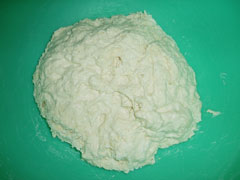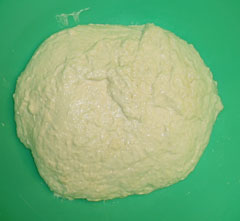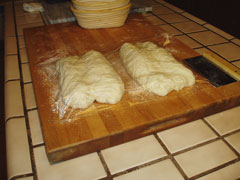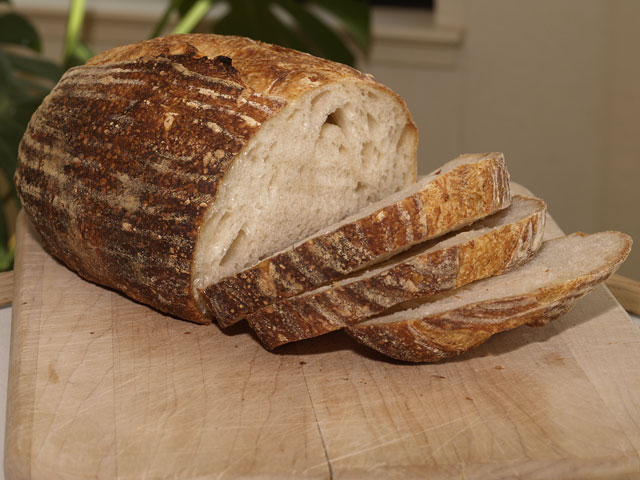Twelve days ago I posted this topic about my troubles with an all white flour version of my successful whole wheat and rye starter. Since then I have been nursing that starter with multiple daily feedings, and keeping it quarantined from my other starter to avoid cross-contamination. Based on research, and excellent direct advice, the issue was diagnosed by David Snyder and Debra Wink (Thanks to both of you!) as thiol degradation and I proceeded to try to "feed through it".
I started out by stepping up the interval but maintaining the 1:1:1 (s:w:f) ratio I had been using. That proved too hectic, and I could not count on getting even the brief mid-day work break I needed to stay on schedule. Even though I work at home, I seemed to end up on the phone for an hour starting just before the starter should be fed. It felt like I was not going to be able to make it work that way so I increased the food supply by going to a 1:3:3 ratio and reduced the frequency to every 12 hours. I also reduced the initial inoculation from 30 grams to 10. I thank Eric Hanner for his valuable input that led me to this action.
I was able to maintain the 12 hour interval successfully, and true to Debra Wink's assurance, on the 10th day things changed. I did not know what I was looking for, but Debra was right: when it happened it was obvious. What I noticed first was a difference in the matured starter when it was time for the next feeding. The viscosity of the "discard" was lower and it was much less sticky as well. It dropped off my spatula almost of it's own accord into the discard jar and left the spatuala mostly clean. Previously I had to scrape and wipe and eventually wash the spatula to get the stuff off. The other change was the volume in the jar. While the bad bugs were in charge there was little loft to the mature starter, even after 12 hours of obvious activity. After the change it started nearly tripling in 12 hours.
I decided to try some loaves, with high hopes for something better than the results pictured in the original post linked above. I made another batch of dough by exactly the same formula and approach as outlined in that post. Because I was not certain where it was going to end up I took pictures at many of the steps, starting with the dough made up, without the salt, and resting for autolyse:

After adding the salt and completing the first set of stretch and folds in the bowl:

I did a total of 3 sets of stretch and folds in the bowl, and here is the dough after the third set:

The original batch of dough that led me here in the first place had broken down almost completely by the time I got this far. Results this time are obviously worlds better. I decided to do a stretch and tri-fold on the bench to get a bit more development, (and because I wanted to get my hands on it and in it to reassure myself it was going to hold together!) so I stretched it out:

and then I folded it up:

At this point I knew I had a dough that was holding up well, with a smooth and supple consistency that had me quite excited, shall we say. I put it into a dough bucket, let it ferment on the bench for about 30 minutes and then put it in the fridge to retard till I could bake it, what turned out to be some 20 hours later. Here it is just before going in to retardation:

and again after the retardation, some 20 hours or so later:

I let this rest on the bench for an hour to take some of the chill off, then preshaped:

and then (45 minutes later) final shaped and put them to proof:

I failed to take a photo of the proofed loaves before baking them, but once ready I baked them sequentially in my La Cloche ceramic baker, at 525F for 7 minutes under lid, turned down to 475 for 5 minutes under lid, removed the lid and baked for 17-20 minutes more, until done. Both loaves were baked to internal temperatures of roughly 205F-207F.
So, after all of that, I pulled these out:

and the crumb:

I found that I am so accustomed to my "other" sourdough that includes both a home-ground whole wheat flour component and a dark rye flour component that on first encounter this bread tasted somewhat bland to me. As we worked our way through that first loaf though I began to detect subtle flavors that brought the bread to life for me. It is still a much milder flavored bread than "my" sourdough, but it is also a very pleasant flavor that goes well with sandwiches, and as toast or french toast at breakfast. Also, because it is almost entirely All Purpose flour, I find it almost too soft and fluffy in the crumb. This also makes the crust somewhat insubstantial, and I will start increasing the bread flour to gradually work up to a crust and bite that is more pleasing to us.
It has been a rewarding journey, and it was nice to "win the battle" with that whatever-it-was nasty that took over my starter. Interestingly, although I did have to significantly modify how I was feeding my starter in order to get to this point, I did not have to reduce the hydration. I maintained the original 100% hydration in this starter all the way through, even to now. Having gotten this far, though, I think I will split the starter into this original and a lower, perhaps about 60%, hydration version so I can experiment with the different flavors they produce. The mildness of the flavor of this 100% hydration version may make the differences easier for me to pick up on my unsophisticated palatte.
I want to thank everyone that contributed advice on this issue. The expertise shared, and the spirit of generosity with which it is so readily shared, here on The Fresh Loaf is a true blessing. You are helping to make me a better baker.
Thanks for stopping by
OldWoodenSpoon